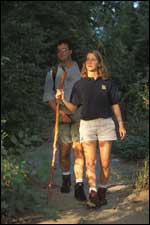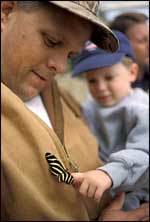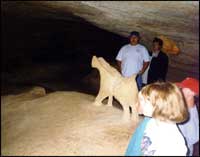Nature Walk

Few individuals walking through a nature area are aware of the many things in full view, much less the features that require closer observation. As young naturalists, you should become more aware of your surroundings and strive to develop your powers of observation.
What do you see when you look at a tree? If you view it as a single object, you are missing a world of nature. Take a closer look—really study the tree. Now what do you see? Perhaps closer observation has revealed a bird nest on the high branch where a mother bird is feeding her young; or a songbird hopping from limb to limb, pausing to fill the air with his clear, melodious calls; or a woodpecker busily searching for insects in the bark crevices. What is that on the underside of the lower branch? Look, there it is again: a small tree lizard so nearly the color of the wood that it seems to disappear when still. This protective camouflage helps conceal the lizard from both its prey and the hungry predators that seek it for food.

If you become aware of the world of nature around, your curiosity may be aroused. You may begin to wonder what kind of tree you were observing; which species of birds were seen nesting, hopping from limb to limb, or gathering insects; which type of lizard was hiding in the tree; what kind of spider had placed her web between those branches; and which tree frog that was and how it could cling to the side of that limb so easily.
To help you identify the plants and animals you see on your nature walk, there are many good field guides available. For example, the Peterson Field Guide Series includes A Field Guide to Trees and Shrubs by George A. Petrides, A Field Guide to the Birds of Texas and Adjacent States by Roger Tory Peterson, A Field Guide to Reptiles and Amphibians by Roger Conant, and A Field Guide to the Insects of America North of Mexico by Donald J. Borror and Richard E. White.

While making your nature walk, don’t limit your observations to trees and their contents. The ground also has its story to tell. The passage of wildlife through an area leaves signs for all to see. Each species of animal has its own distinct footprint, and by learning to identify them, you will be able to tell which animals have walked where you are walking. When the deer, raccoons, opossums, bobcats, and other animals come to drink, their tracks are recorded in the moist soil around the water’s edge.
A Field Guide to Animal Tracks by Olaus J. Murie will help you identify the tracks you encounter o your walk. If you wish to preserve the tracks and start a collection of them, you may make plaster casts. To do this, first carefully clean the twigs and loose dirt from the tracks. Cut the ends out of a tin can that is larger than the track and cover the inside of the can with a coating of Vaseline to make removal of the cast easier. Place the can over the track. Mix together plaster of paris and water to a consistency of thick cream or pancake batter. Pour it into the can about an inch thick and let it dry for an hour. Remove the cast from the can, let it dry for another hour or so, and then clean it thoroughly with water to remove all dirt. Allow the cast to dry for two or three days before adding a protective coating of shellac.
While your eyes are busy observing the world around you, your ears should be listening for the sounds of nature. The call of a bird will pinpoint its location for you. The steady drone of buzzing bees may lead you to their hive. Hearing the rustle of dead leaves could draw your attention to an armadillo foraging for food, a lizard currying for safety, or some other small wildlife creature hurrying about its daily business. These sightings f wildlife could be missed if your ears are not tuned in on the sounds of nature.
Now that you are excited about going for a nature walk to see what you can see, don’t think that because you have no little wooded place in the country you have no place to go. Nothing could be further from the truth. Your backyard or the vacant lot on the corner can be fascinating if you look and listen hard enough. Most state parks also have areas available for hiking and exploring, and many have actual trails, some of which have signs identifying the vegetation along the route.
Spend some time in the outdoors on a nature walk. You may be surprised at the variety of living things you will encounter.
Ilo
Hiller
1983 Nature Walk. Young
Naturalist. The Louise
Lindsey Merrick Texas Environment
Series, No. 6, pp. 2-4.
Texas A&M University
Press, College Station.